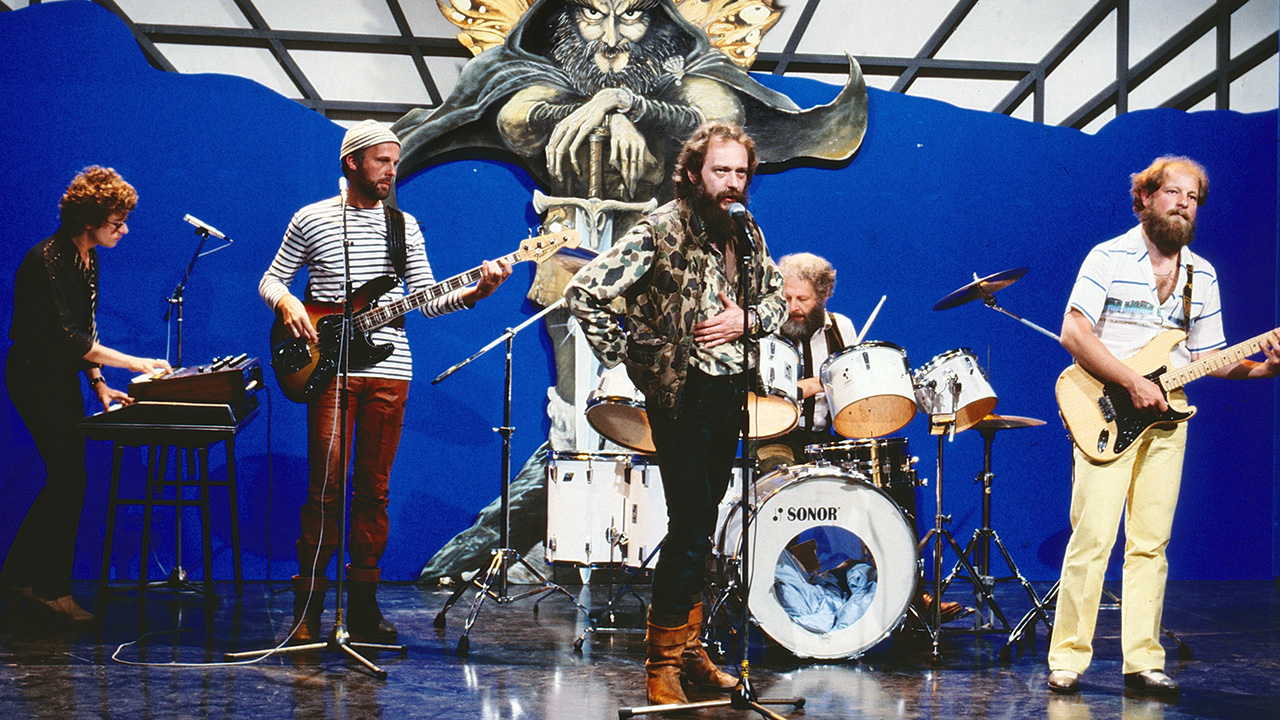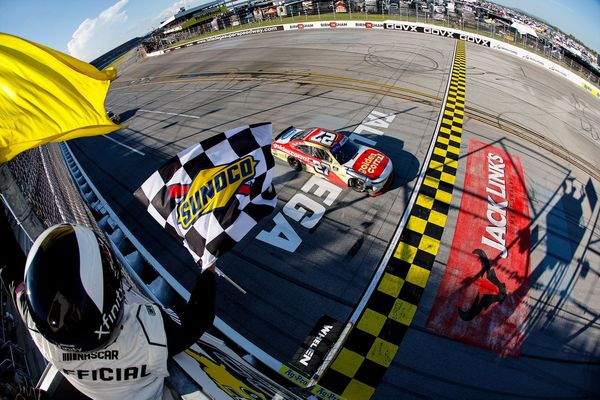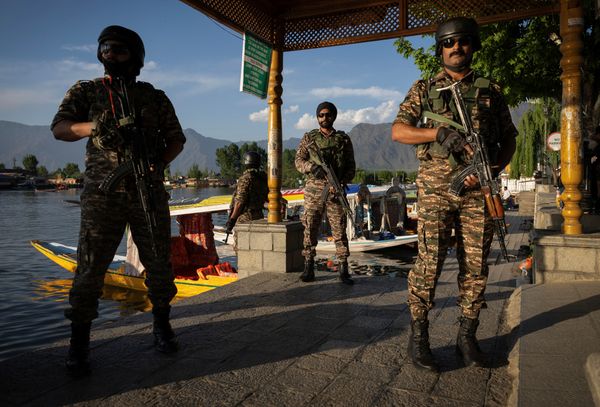
When Jethro Tull released The Broadsword And The Beast in 1982, many of their fans breathed a sigh of relief: it seemed their favourite band had returned to their more traditional folk rock roots. Ian Anderson reveals the story behind the recently reissued and expanded album that he reckons contains some of Tull’s best music.
If ever Ian Anderson were to doubt the enduring popularity of Jethro Tull’s 1982 album The Broadsword And The Beast, he gets regular reminders of it when he meets long-time fans of the band. Perhaps not actually written all over their faces, but close enough.
“I’ve been asked to sign many an album-sized tattoo of the album cover on somebody’s back,” he says, “which is embarrassing, but I’ve seen very good likenesses of the album cover in glorious colour on the flesh of human beings. It’s beyond me why people do that sort of thing, but perhaps that’s a reflection of the affinity some fans feel to it.”
They can immerse themselves even more fully in it as the 40th anniversary edition (slightly delayed thanks to that pesky pandemic) has been released, offering an 81-track expanded version of the album replete with Steven Wilson remixes, live renditions, and a handful of previously unreleased tracks.
Its original launch came at a pivotal time in the band’s history, ending their first ever two-year interval between albums following 1980’s A, a record initially planned as an Ian Anderson solo release and featuring a new line-up of contributors (amid personnel-related upheaval often referred to as the band’s “big split” after a Melody Maker headline to that effect). With A having incorporated electronic instrumentation and framed in an overhauled band image reimagining Tull in white boiler suits, as if preparing for a nuclear attack or engagement with extra-terrestrials, it seemed this much-loved cornerstone of the British prog scene was shifting its shape more comprehensively than many fans were prepared for.
All this at a time when critics were busy attempting to ram the whole genre into the dustbin of a rewritten rock history in the wake of punk, and some leading progressive acts were responding with artistic rethinks in a sometimes misguided bid to stay relevant and still get played on the radio.
So when The Broadsword And The Beast emerged in April 1982, it was a relief to find the white coats ditched and Anderson, Martin Barre and friends reborn in the guise of figures from a fantasy novel, amid artwork that suggested a return to territory infinitely more agreeable to their fanbase’s tastes.
The music was still interwoven with the shiny synth sounds and modern production techniques that characterised A, but the playing on tracks such as opener Beastie had a flintier edge and Anderson a demonic twinkle in his eye as he sang of’ the hundred names of terror, creature you love the least’, and the need to ‘exorcise the beast’.
“I guess it’s seen as a return to more traditional Jethro Tull style,” says Anderson, but that perception is not entirely borne out when listening to the record, whether the original album or its demo versions on this reissue. Punchy synth hooks and quintessentially 80s guitar riffs frame Flying Colours, before Watching Me, Watching You is built on knots of squirming synth that could’ve easily found themselves on the band’s next album, the fully electronic-embracing Under Wraps.
There’s also an electronic sheen coating the flute motif of Pussy Willow and the synthesised brass of Broadsword. Unlike on the follow-up album, such modernist touches didn’t feel overbearing and rarely distracted from what was a collection of stirring, often anthemic Tull songs in essence. Either way, though, this was clearly the work of a markedly different band to that which had ended the 1970s with the folk rock trilogy of Songs From The Wood, Heavy Horses and Stormwatch.
Although Barre, Anderson’s chief lieutenant, endured from that incarnation of the band and his guitar work would continue to stand out, even his sound would undergo a makeover. This process had begun with A, whose creation resulted in the messy departure of long-time Tull members Barriemore Barlow, Dee Palmer and John Evan (following the illness and subsequent passing of bassist John Glascock) and the introduction of former Roxy Music man Eddie Jobson as guest keys player and co-songwriter. Before The Broadsword And The Beast had begun to take shape, Jobson in turn made way for tech-savvy keyboardist Peter-John Vettese, while US-based drummer Mark Craney was replaced by former Cat Stevens percussionist Gerry Conway.
Anderson has described new boy Vettese, then 25, as looking like “Gerald Bostock with a synthesiser”, but he undoubtedly made his mark pretty quickly on several tracks, from the techno pulse underpinning Watching Me, Watching You to the piano confections bookending Flying Colours. “He looked younger than his years,” says Anderson, “like a speccy schoolboy. But he was a very bright guy. And he had an amazing natural aptitude for hearing something and then being able to play it and develop it.”
His introduction was evidently a factor in Tull’s continued path towards a more modernist sound, which Anderson looks back on with mixed feelings. Within this early 80s period, though, Broadsword is the moment when Tull most consistently hit a sweet spot between 70s folk rock, 80s FM rock and AOR.
Anderson feels that Conway’s drumming was a key component in that sound (the absence of Conway, or indeed any human drummer, from Under Wraps would go far from unnoticed, and his return for Crest Of A Knave would be widely welcomed), and better suited to the material than classic period sticksman Barriemore Barlow.
“Gerry was very analytical in the way that he played, but he had a great economy of style. He certainly didn’t decorate the drum parts in the way that Barrie Barlow had done, which had become increasingly very complex. Barrie was a very skilled drummer but he didn’t leave a lot of bars without doing something quite specific. That was sometimes a little too much.
“If Gerry played a drum break, it would be very emphatic, relatively simple, but very carefully chosen to do the right thing at the right time. It made him delightful to play with... as long as he could remember what it was he played on the record!” Anderson laughs. “I remember onstage Gerry sometimes would just go blank, thinking, ‘I don’t know where I am in the song’, not knowing what’s coming next. He’d apologetically sort of dig himself out of a train wreck...”
Another aspect of Broadsword’s evolution, often disregarded by the casual listener but pivotal to the musicians creating it, was the choice of producer. Anderson himself has always been hands-on at the production stage of things, sometimes listed as sole producer on Tull records. “I really thought it’d be a good idea to have the independent eyes and ears of a producer,” he recalls, but after Canadian production heavyweight Bob Ezrin pulled out due to family reasons, Chrysalis suggested former Fleetwood Mac producer Keith Olsen. However, the new man in the control room jarred with his new charges due to what Anderson diplomatically refers to as “his recreational activities”, and lasted barely a week, after which the singer reverted to an old-fashioned approach.
“I took to the Yellow Pages [business directory],” he says, “and started looking under ‘record producers’. There wasn’t a lot to choose from, but Paul Samwell-Smith’s name cropped up. So I just gave him a call. I knew about his early days [playing] with the Yardbirds, and I think he’d worked with Cat Stevens, so probably with Gerry Conway in the past.”
There were no ‘lifestyle’ clashes in this case, happily. “He was a very gentlemanly, quiet, laid-back guy, didn’t smoke, drink, do drugs, he just turned up on time, listened carefully to the music, made a few suggestions and was able to do the mixing process alongside our engineer Robin Black, which meant I could sit at the back of the room and listen, rather than being just totally engaged all the time with stuff. And I think that was maybe what made Broadsword a fun album to make.”
Ultimately, though, the enduring appeal of this album lies in the songs, which took shape in earnest when Anderson began to explore new ways of writing. “We were without a keyboard player to begin with, so I bought a bunch of what were then state-of-the-art keyboards, and used them probably more than I used guitar for writing the songs.
“I’d set up a studio at home, so we were rehearsing and recording in close proximity, which meant as soon as we had something on the go, we could press the red button and record it. It keeps the ideas very current and stops you kind of going off the boil.”
Positioned in the Tull discography between two albums that seemed to have the Cold War concerns of the early 1980s close to the surface, Broadsword mostly focuses on less topical subject matter. The title track, for instance, was the result of Anderson drawing on the history around his home on the Isle of Skye. “I was picturing the Viking invaders who set about plundering and pillaging the coasts around the northern part of the UK,” he says. “I had a mental picture of a hill fort called Dun Ringill on the Isle of Skye, which was built as a stone keep that would allow the villagers to entomb themselves in the hope that the Vikings couldn’t get at them.
“When you look down the sea loch from there, you get an incredible view for a long, long way, and I always had that image in my head of somebody spying a dark sail on the horizon – a Viking longship, or more likely a fleet of them, coming to set about the place.” As such, it makes the song Broadword something of a sequel to Dun Ringill from 1979’s Stormwatch, which sketched a picture of inhabitants meeting as the skies darken to ‘watch the old gods play’.
Similarly evocative is Seal Driver, a windswept evocation of adventure on the seas, wherein our hero asks, ‘Could you fancy me as a pirate bold, Or a longship Viking warrior with the old gods on his side?’
If there’s a key characteristic to these songs, it’s soul, with a small ‘s’ – a powerful, emotional resonance. The same is undoubtedly true of two more of the most enduring favourites from this album: Slow Marching Band and Cheerio. The former resembles a long- lost cousin of Auld Lang Syne in its elegiac request to ‘take pleasure in your leaving’ and ‘walk on slowly, don’t look behind you’, and at the time Prog speaks to Anderson, it turns out its sentiments are on his mind more than usual.
“Slow Marching Band is a memorial song,” he says. “It is a funeral march, essentially. But I tried to give it some bit of a spin to be positive and upward thinking. And as I sit here today, I’m planning my brother’s funeral a few days hence. “Death is a fact of life and perhaps writing those kinds of songs in its own little way does prepare you for the inevitable. I lost my father prior to the recording of Broadsword, and it’s part of what we all face. So I feel that a funeral service should be a celebration of somebody’s life, not just about mourning.”
Cheerio offers a lullaby-like end to the album, coating apparently unhappy events in similarly hopeful sentiments. “It’s a natural bed partner [to Slow Marching Band], really,” says Anderson. “Although it’s not necessarily about death, just the parting of ways. It could be saying goodbye to family after lunch, it could be saying goodbye to a loved one in a failed relationship, but it is a goodbye, and again something that is intended to be uplifting.”
Cheerio also served as the farewell number in the band’s live shows for many years, and it reflects an approach to ending shows that Anderson feels strongly about. “We refer to it as ‘the bows’. After the encore, we bow to the audience while Cheerio is playing. And for me it’s a very fitting thing: it’s not the end, we’re not going to go and slit our wrists in the dressing room after the show; it’s bidding a fond farewell. And I feel that does somewhat mark Jethro Tull out from a whole bunch of other bands who do this sort of fist-punching celebration load of old bollocks. People who do that make me puke, getting everybody to sing the words with them and all that rubbish. I just have always been repelled by the desperation of bands to get audience participation.
“Frankly, the day I ask the audience to sing my songs, I might as well pack up and go home. It’s hard enough for anybody, even trained singers, to sing these songs, let alone an audience who will massacre it. So my approach, since pretty early days, is to calm things down at the end of the show.”
If those songs still contain sentiments that strike a chord with their author to this day, two of the more pointedly topical tracks also draw on themes that are by no means outdated 40-plus years on. Fallen On Hard Times came out just as the UK was feeling recession bite and is now reissued as the cost of living crisis is particularly acute, while Watching Me, Watching You taps into issues troubling 21st-century citizens even more: the unsettling sense of being spied on wherever you go.
“That song is about that feeling of discomfort I’ve always had about staring at people and them staring at me,” Anderson explains, “but now, of course, it would also be about being observed and captured by people on their omnipresent cellphones. I have to accept that it’s going to happen, but I don’t enjoy that intrusion, especially when I’m somewhere trying to have a private moment, and then there’s somebody videoing me when I’m eating my breakfast. I do get pretty annoyed about that.
“It’s something you have to accept in this kind of line of work. People are going to look at you and think, ‘Is that him? Is that who I think it is? Is it Ian Anderson? No, it could be [politician] Matt Hancock, I’m not sure.’ But I’m as guilty as anybody else. In the song, I’m imagining sitting in a train carriage and looking out the window and staring at people. You tend to look and sometimes people look back at you, and sometimes people catch your eye, and for all I know they might be feeling uncomfortable, feeling that I’m stealing a little part of their soul. But having begun life aspiring to the painterly arts and photography, looking at people and searching their soul is part of what I do as a songwriter.”
At other times as a writer, however, he’s not above settling scores, as was the case on one of the many out-take demos and alternate versions that are included on the 71 extra tracks on this sumptuous anniversary reissue package. Highlights include material that didn’t make the cut onto the original album, such as the robust flute-led rock of Overhang, the Supertramp-like Drive On The Young Side Of Life and the folky, mandolin-accompanied Inverness Sleeper.
But one that stands out for Anderson is a pointed dig at those who, by 1982, had written off Jethro Tull as relics of a bygone age. ‘I won’t lie down,’ he sings in between defiantly proggy keyboard flourishes on Me, Dinosaur. “It’s a great song,” he says, “but a bit childish in its petulant response to the term being applied to progressive rock bands of the 70s. On the War Child album I wrote a similar song [Only Solitaire] digging at music writers after they’d said something nasty about Jethro Tull. It’s not an attractive emotion to express, in hindsight.”
At the time of its release, The Broadsword And The Beast didn’t convince many progophobes to revise their opinion of the band, but it has since built a prominent place in the hearts of long-serving Tullophiles. But while we can immerse ourselves in several different studio versions of he tracks on this reissue, plus live readings of them, there are no plans for any whole-album shows revisiting the LP in full onstage. Nor, alas, will we again see the like of the ornate stage sets that grew from the album artwork, as it was at this point that Ian Anderson finally concluded that things were getting out of hand. A pirate ship jutting out onto the stage? Anderson in a giant latex Beastie costume? What’s not to like?
“It was an honest attempt to come up with something theatrical,” he says. “And we didn’t have video backdrops and screens back then, so I wanted to make the show visually interesting. We weren’t the only people doing that sort of thing, with Pink Floyd having done The Wall. I don’t know if Iron Maiden ever saw it, but they do the same sort of thing very well today.
“But, for me, Broadsword was one step too far. It looked great on paper, when we came to the dress rehearsals, I thought, ‘Oh my God, that’s kind of embarrassing.’ It probably looked better when the stage lights were on, but it must have looked pretty naff when people first walked into the venue.”
Looking back on the album now, Anderson reiterates his fondness for it. “It didn’t do very well in America for some reason, but it was particularly popular in Europe,” he says. “I think it still is our highest-selling album in Germany on initial release. And to this day we’ll still regularly play a song or two from the album live.”







